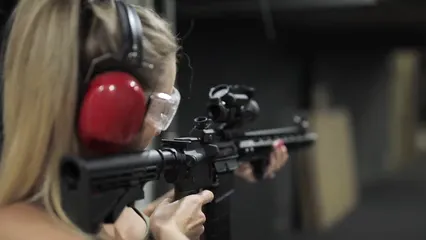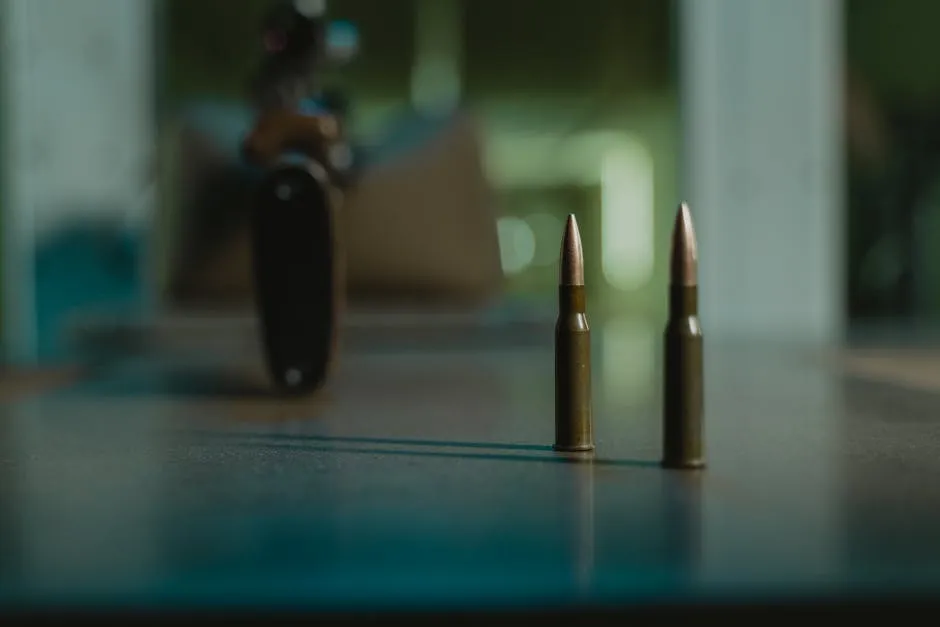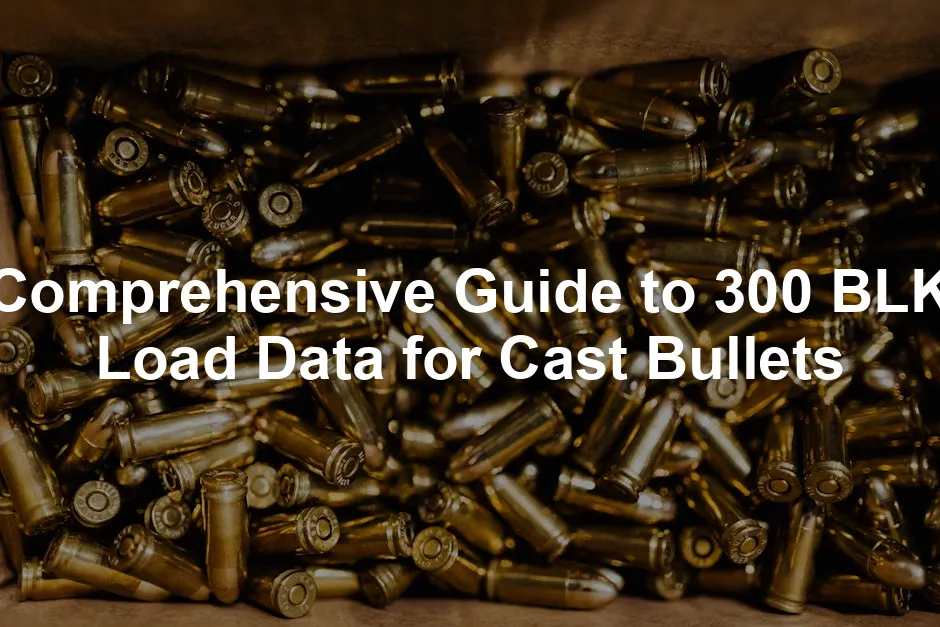Introduction
Are you interested in reloading for the 300 Blackout (300 BLK) using cast bullets? You’re not alone! Many firearm enthusiasts are diving into casting and reloading. This article aims to provide you with detailed load data, useful tips, and best practices for using cast bullets in the 300 BLK.
Summary and Overview
The 300 Blackout cartridge holds a special place in the shooting community. Its versatility allows it to excel in various applications, from plinking to hunting. One of the standout benefits of using cast bullets is cost-effectiveness. Additionally, they offer customization options that factory ammunition cannot match.
However, sourcing reliable load data for cast bullets can be challenging. Often, information is scarce or difficult to find. This article compiles user experiences and expert recommendations to help you navigate these challenges and enhance your reloading experience.

Understanding the 300 Blackout Cartridge
Overview of the 300 Blackout
The 300 Blackout (300 BLK) was developed to provide a versatile cartridge that could operate effectively in both subsonic and supersonic applications. It was initially introduced as the .300 Whisper and later rebranded to the current name. This cartridge is based on the .223 Remington case, necked up to .30 caliber.
The 300 BLK is popular among shooters for its effectiveness in short-barreled rifles and suppressors. Its specifications allow for a range of bullet weights, typically from 110 to 250 grains. The cartridge’s flexibility makes it suitable for various shooting disciplines, including tactical shooting and hunting.

Advantages of Using Cast Bullets
Using cast bullets for reloading offers several advantages. First, they are significantly more cost-effective than commercial bullets. This can lead to considerable savings for frequent shooters. Second, casting your own bullets allows for customization. You can adjust weight, shape, and hardness to meet your specific needs.
Moreover, cast bullets can deliver impressive accuracy and performance. Many shooters find that well-cast bullets can rival their jacketed counterparts. However, it’s essential to note that achieving optimal results may require some experimentation with loads and techniques.
For more insights on enhancing your shooting accuracy, check out solutions for improving data accuracy with wireless loggers in industrial applications.

Reloading Basics for 300 Blackout
Essential Equipment for Reloading
Starting your reloading journey for the 300 Blackout requires a few essential tools. First, you’ll need a reloading press to assemble your cartridges. The Lee Classic Turret Press is a popular choice due to its affordability and versatility. Next, invest in quality resizing and seating dies. The Redding Competition Seating Die is highly recommended for precision.
Don’t forget a good bullet mold! For cast bullets, the Lee 230 Grain Mold works wonders. It produces consistent, reliable bullets for both subsonic and supersonic loads. A digital scale is vital for measuring powder accurately. The Frankford Arsenal Digital Scale is user-friendly and precise.
Safety should always come first. Purchase safety glasses and hearing protection for your reloading sessions. Always follow safe practices, like wearing gloves and working in a well-ventilated area. Reloading can be enjoyable, but it’s crucial to prioritize safety to avoid accidents.

Sourcing Load Data for Cast Bullets
Finding reliable load data for cast bullets in the 300 Blackout can be quite tricky. There’s a noticeable lack of published information specifically for cast bullets. Many reloading manuals focus on jacketed bullets, leaving cast bullet reloaders searching for answers.
For those looking to gather load data, several reputable sources can help. The Lyman Cast Bullet Handbook is a classic reference, offering valuable insights into various calibers, including the 300 BLK. Online forums, like Cast Boolits and The Firing Line, are excellent places to exchange ideas and experiences. Users often share their personal loads and successes.
Don’t underestimate the power of community input. Engaging with fellow reloaders can provide you with unique insights and tips. Remember to keep an open mind and stay safe as you experiment with different loads and techniques!

Cast Bullet Load Data for 300 Blackout
Popular Cast Bullets and Their Specifications
When selecting cast bullets for the 300 Blackout, several weights and designs stand out. Popular choices include the 155gr and 230gr bullets. The 155gr bullet is often used for supersonic loads, offering a good balance of velocity and accuracy. Meanwhile, the 230gr bullet shines in subsonic applications, providing excellent performance with low recoil.
Bullet design also plays a crucial role in performance. Flat-nose bullets, such as the Lee 230gr, are ideal for target shooting and hunting. Their shape allows for better expansion upon impact. Round-nose designs, on the other hand, can offer smoother feeding in semi-automatic firearms, making them a good option for reliable cycling.
Your choice of bullet will depend on your intended use. Whether you’re plinking at the range or heading out for a hunt, selecting the right bullet can significantly impact your shooting experience. Always conduct thorough testing to find the perfect load for your needs!

Recommended Powders for Cast Bullets
When it comes to loading cast bullets for the 300 Blackout, selecting the right powder is crucial. Here are some suitable powders for various bullet weights:
- AA1680: This powder is popular for subsonic loads, particularly with heavier bullets like the 230 grain. Users appreciate its consistency and performance.
- H110: A favorite for supersonic loads, H110 works well with lighter bullets, such as the 155 grain. It burns cleanly and provides reliable ignition.
- RE7: This powder is versatile and efficient, making it suitable for both subsonic and supersonic applications. Many users report excellent accuracy with RE7.
Burn rates matter. For subsonic loads, slower-burning powders like AA1680 allow for better velocity without exceeding pressure limits. In contrast, faster powders like H110 are ideal for achieving higher velocities with lighter bullets.
Users often share their experiences online. One user mentioned that 11.4 grains of AA1680 produced clean results with minimal leading. Another reported success with H110, achieving reliable cycling in their rifle.
Adjusting your load based on user feedback can be beneficial. Always start with lower charges and work your way up. This approach helps ensure safety while finding the most accurate load for your needs.

Load Recipes and Starting Points
Let’s get into some sample load recipes for popular cast bullets in the 300 Blackout. Here are starting points you can try:
- 155 Grain Lee C312-155-2R:
- Powder: AA1680
- Starting Load: 11.0 grains
- Notes: This load offers a good balance of accuracy and recoil. Users report minimal leading when using gas checks.
- 230 Grain Lee 230-5R:
- Powder: H110
- Starting Load: 10.5 grains
- Notes: Ideal for supersonic loads, this recipe is popular for its consistent performance and reliability.
- 160 Grain Lee C312-160-2R:
- Powder: RE7
- Starting Load: 16.0 grains
- Notes: This load works well for both subsonic and supersonic applications, depending on the charge. Users have noted exceptional accuracy with this combination.
It’s essential to start with lower loads and gradually work up. This practice allows you to monitor for pressure signs and optimize performance.
Forums like Cast Boolits and The Firing Line can be valuable resources. Users frequently share their pet loads and results, helping you to refine your own.
Remember, each firearm may react differently. Take your time and document your results. This way, you can pinpoint the most effective load for your specific setup.

Best Practices for Casting and Reloading
Techniques for Successful Bullet Casting
Casting your own bullets can be a rewarding experience, but a few key techniques can enhance your results. First, ensure you have the right equipment. A quality melting pot, like the Lee 4-20 Melting Pot, is essential for maintaining consistent temperatures.
Temperature control is critical. Aim for a lead pot temperature between 700°F and 800°F. This range allows for smooth pouring and minimizes defects.
Alloy choices matter too. Using wheel weights is common, but consider adding tin for better fill-out. A mix of 20% tin to 80% lead can improve hardness and performance.
Sizing and gas checks are vital steps. Properly sized bullets should fit snugly in your barrel. Gas checks help prevent leading, especially when shooting at higher velocities.
Finally, always clean your molds thoroughly before use. This practice ensures better bullet quality and reduces imperfections. With these techniques, you can achieve consistent, high-quality cast bullets for your 300 Blackout.
Troubleshooting Common Issues
When it comes to using cast bullets in the 300 Blackout, several challenges may arise. Leading is a common issue that many reloaders encounter. This occurs when lead deposits accumulate in the barrel, affecting accuracy and performance. To combat this, consider using gas checks. Gas checks help seal the bullet base, reducing the chances of leading, especially at higher velocities.
Another frequent problem is accuracy. You might notice your shots grouping poorly or flying off target. This could be due to several factors. One significant factor is bullet sizing. Ensure your cast bullets are sized correctly to match your rifle’s bore diameter. A bullet that’s too small can lead to gas cutting, while one that’s too large may not chamber properly.
User testimonials often highlight these issues. For example, one reloader reported significant improvements in accuracy after switching from a 230-grain bullet to a larger, properly sized 160-grain bullet. They also found that using a lighter crimp allowed for better performance.
Adjustments in technique can also yield positive results. Experimenting with different powders, like AA1680 or RE7, may help fine-tune your loads. One user shared their success with 11.4 grains of AA1680, experiencing minimal leading and impressive accuracy.
Remember, every rifle is unique. It may take time and experimentation to find what works best for you. Don’t hesitate to reach out to the reloading community for support and shared experiences. With patience, you can overcome these challenges and enjoy the benefits of casting bullets for the 300 Blackout.

Conclusion
In summary, using cast bullets in the 300 Blackout opens up exciting possibilities. We’ve discussed the importance of proper sizing, choosing the right powders, and overcoming common issues like leading and accuracy. As you experiment with your loads, always prioritize safety and start with lower charges.
I encourage you to share your experiences with the community. Have you found a particular load that works well? Your insights could help fellow reloaders on their journey. Let’s learn together and make the most of our casting adventures!

Frequently Asked Questions
1. Can I use jacketed bullet load data for cast bullets in the 300 Blackout?
Yes, you can use jacketed data as a starting point. However, always prioritize safety. Cast bullets typically require less powder. Start with lower loads and work your way up to avoid excess pressure. Keep in mind that performance may vary based on factors like alloy strength and bullet fit. Always test your loads in small increments to ensure safety and accuracy.
2. What alloys are best for casting bullets for the 300 Blackout?
When it comes to casting bullets for the 300 Blackout, choosing the right alloy is vital. Common casting alloys include wheel weights, pure lead, and linotype.
Wheel weights are popular due to their availability and affordability. They typically contain around 3% antimony, providing decent hardness for most applications. However, it’s essential to ensure they are free of zinc, as zinc contamination can lead to poor casting results.
Pure lead, while softer, is suitable for subsonic loads. It offers good expansion upon impact, making it ideal for hunting. Just remember that softer bullets may lead to barrel fouling, especially at higher velocities.
Linotype is another option. This alloy features a higher tin and antimony content, resulting in harder bullets. It’s excellent for high-velocity loads, providing better accuracy and less leading in the barrel.
For the best results, consider blending these alloys. A mix of wheel weights and pure lead can balance cost and performance. Ultimately, testing different alloys will help you find the perfect fit for your shooting style and needs.
3. What are the best powders for subsonic loads in 300 Blackout?
Selecting the right powder for subsonic loads in the 300 Blackout is crucial for optimal performance. Here are some recommended powders that have proven effective:
- AA1680: This powder is a top choice for subsonic applications. Its slow burn rate helps achieve consistent velocities while keeping pressure low. Many reloaders report excellent accuracy with this powder, especially when using heavier bullets.
- H110: While typically used for supersonic loads, H110 can also work well for subsonic applications with specific bullet weights. It burns cleanly and provides reliable ignition, making it a versatile option.
- RE7: This powder is known for its efficiency and versatility in both subsonic and supersonic loads. Many users have reported great results with accuracy and consistency when using RE7.
- IMR 4227: This powder is suitable for subsonic loads and offers good performance with a variety of bullet weights. It burns cleanly and can help reduce leading in the barrel.
Always start with lower charges and gradually work up, paying attention to pressure signs. Each firearm may react differently, so testing various powders will help you discover the best fit for your needs.
4. How do I know if my cast bullets are sized correctly?
Bullet sizing is a crucial factor in achieving accuracy with 300 Blackout loads. Properly sized bullets fit snugly in the barrel, creating a good gas seal. If the bullets are too small, gas can escape, leading to poor accuracy and potential leading. Conversely, bullets that are too large may not chamber correctly.
To determine if your cast bullets are sized correctly, measure their diameter using calipers. For the 300 Blackout, a typical bore diameter is around .308 inches. Ensure your bullets match or slightly exceed this measurement for optimal fit.
Test your loads at the range. If you notice keyholing or erratic groupings, it may indicate sizing issues. Adjust your sizing die as needed and retest.
Remember, achieving the right fit can take some experimentation. Don’t hesitate to consult reloading forums and communities for insights on bullet sizing specific to your firearm.
5. What are the most common mistakes when reloading cast bullets?
Reloading cast bullets can be rewarding, but it’s easy to make mistakes. Here are some common errors and how to avoid them:
- Ignoring Proper Sizing: Failing to size bullets correctly can lead to accuracy issues and leading in the barrel. Always measure your cast bullets and ensure they fit your rifle’s bore.
- Using Incorrect Powder Charges: Many new reloaders mistakenly use jacketed bullet data for cast bullets. Start with lower charges and work up to avoid excess pressure.
- Neglecting Alloy Hardness: Using the wrong alloy can affect performance. Softer alloys may lead to leading, while overly hard ones can cause poor expansion. Experiment with different alloys to find the right balance.
- Overlooking Gas Checks: Failing to use gas checks with high-velocity loads can result in leading and decreased accuracy. Ensure you have gas checks on hand when needed.
- Not Keeping Detailed Records: Many reloaders forget to document their loads. Keep a log of your recipes, bullet weights, and powder charges. This practice helps identify what works best and allows you to replicate successful loads.
By being mindful of these common mistakes, you can improve your success with reloading cast bullets for the 300 Blackout.
Please let us know what you think about our content by leaving a comment down below!
Thank you for reading till here 🙂
All images from Pexels




